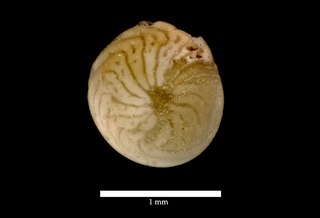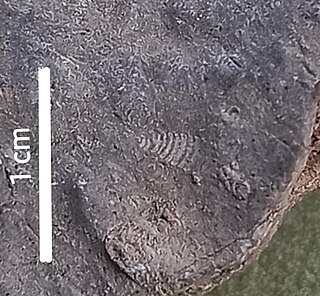Related Research Articles

The Globigerinina is a suborder of foraminiferans that are found as marine plankton. They produce hyaline calcareous tests, and are known as fossils from the Jurassic period onwards. The group has included more than 100 genera and over 400 species, of which about 30 species are extant. One of the most important genera is Globigerina; vast areas of the ocean floor are covered with Globigerina ooze, dominated by the shells of planktonic forms.

The Allogromiida is an order of single-chambered, mostly organic-walled foraminiferans, including some that produce agglutinated tests (Lagynacea). Genetic studies indicate that some foraminiferans with agglutinated tests, previously included in the Textulariida or as their own order Astrorhizida, may also belong here. Allogromiids produce relatively simple tests, usually with a single chamber, similar to those of other protists such as Gromia. They are found as both marine and freshwater forms, and are the oldest forms known from the fossil record.

The Rotaliida are an order of Foraminifera, characterized by multilocular tests (shells) composed of bilamellar perforate hyaline lamellar calcite that may be optically radial or granular.
The Rotaliacea is a superfamily of mostly benthic foraminifera in the order Rotaliida.

The Textulariida are an order of foraminifera that produce agglutinated shells or tests. An agglutinated test is one made of foreign particles glued together with an organic or calcareous cement to form an external shell on the outside of the organism. Commonly, the order had been made up of all species of Foraminifera with these types of shells, but genetic studies indicate these organisms do not form an evolutionary group, and several superfamilies in the order have been moved to the order Allogromiida. The remaining forms are sometimes divided into three orders: the Trochamminida and Lituolida, which have organic cement, and the Textulariida sensu stricto, which use a calcareous cement. All three orders or superfamilies are known as fossils from the Cambrian onwards.
Carterina is a genus in the family Trochamminidae, composing its own subfamily Carterininae. The genus is described from specimens gathered during the Challenger expedition's circumnavigation of the Earth from 1872-1876.

The Asterigerinacea is a superfamily of Foraminifera included in the order Rotaliida, proposed by Loeblich and Tappan in 1988.
The Spirillinida are an order of foraminifera in which the test, or shell, primitively consists of an enrolled open tube, coming after the proloculus, wound planospirally or conically, commonly composed of an optically single crystal of calcite. The aperture is a simple opening at the end of the tube. Advanced forms with more than one chamber may consist of a few crystals, or rarely, a mosaic of crystals of calcite.
Acervulinacea is a superfamily in the Foraminifera order Rotaliida. The Acervulinacea may be free, or able to move about, or their tests may be attached to some substrate. The early growth stage is spiral, followed by irregular chambers that form an irregular mass, disc, or branching structure. The test wall is of hyaline (glassy) optically radial calcite and is coarsely perforate. Apertures are present only as mural pores.

Cibicides is a genus of cosmopolitan benthic foraminifera known from at least as far back as the Paleocene that extends down to the present.
Discorbis is a genus of benthic Foraminifera, that made its first appearance during the Eocene. Its present distribution is cosmopolitan.
Neoconorbina is a genus of recent (Holocene) discorbacean foraminifers related to Rosalina with a low conical trochoidal test, circular in outline. The conical side is the spiral side, on which all three whorls are visible, the final chamber taking up most of the periphery. The umbilical side is flat to concave. exposing only the three to four chambers of the final whorl around an open umbilicus. Chambers on the umbilical side have triangular to platelike umbilical extensions as with other rasalinids. The wall of is calcite, finely and densely perforate on the spiral side, more coarsely perforate on the umbilical side; surface smooth; aperture at the umbilical margin of the chamber, beneath the platelike extension, or folium.
Astrononion is a genus of foraminifera in the family Nonionidae, characterized by an evolute planispiral test with radially stellate structures partly covering the sutures on either side. The test is free, bilaterally symmetrical; periphery broadly rounded; chambers distinct, separated by depressed radial sutures, increasing gradually in size, and usually inflated; aperture a low arched opening at the base of the face of the test. The wall is of finely perforate monolamellar granular calcite.
The Nonionidae is a foraminifera family within the order Rotaliida and part of the Nonionacea, shells, or tests, of which are planispiral or trochospiral, calcareous and finely perforate. Includes the Nonioninae, Pulleniinae, Spirotectinae, and Astrononioninae.
The Globoroatioidea constitutes a superfamily of Cenozoic plantonic foraminifera. It is part of the suborder Globigerinina. Globoroatioidea have trochospiral tests with rounded to carinate peripheries, the walls of which are of finely lamellar, perforate, of optically radial calcite, with an inner organic lining. The surface of these tests is smooth, lacking spines, but may be covered with pustules or pitted, and may have one or more large pores at the center. There is a single primary aperture that may be bordered by an imperforate lip, as well as possible supplementary apertures.

Geinitzina is a genus of Foraminifera from the early Carboniferous (late Mississippian to the late Permian that may have extended into the Triassic. Chambers are uniserial, arranged in a single row, or line. Test wall is double layered. The outer layer is of hyaline radial calcite, and is light in color. The inner layer is of microgranular calcite, and is dark is color. Both layers are secreted by the protoplasm.
Sigmoilina is a miliolid genus, referring to the foraminiferal order Miliolida, characterized by an assymmetricall biconvex test formed by strongly overlapping chambers, one-half coil in length, that form a sigmoid (S-shaped) curve in cross section. The strongly overlapping chambers obliterate earlier ones from view resulting in the compressed biloculine appearance, differing from the squat, depressed biloculine form of Pyrgo and Biloculina. The test, as for all Miliolida, is porcelaneous and imperphorate, the terminal aperture, with tooth, the only point of egress and ingress for the animal.
Triloculinella is a genus of Miliolacean forams with a fusiform to asymmetrically globular test. Inner chambers, one-half coil in length, are crypto-quinqueloculine to quinqueloculine in arrangement; The final three to five visible from the exterior. The aperture is an arch at the end of the final chamber, largely covered by a broad apertural flap, which distinguishes the genus from Triloculina, Quinqueloculina and such, characterized by a more narrow tooth. The wall, as for all miliolids, is calcareous, imperforate, porcelaneous.
Globigerinana are free living pelagic foraminiferan, included in the class Rotaliata that range from the Jurassic to recent. Test are commonly planospiral or trochospiral but may be uniserial to multiserial and are of secreted hyaline (glassy) calcite. Chambers are flattened in planospiral forms and spheroidal in trochospiral and serial forms. Some have long radial spines, or needles that may be solidly fixed or moveable in sockets. Gametes are biflagellate and are produced in greater number than by bottom dwelling benthic forms.

Globothalamea comprises a class of multichambered foraminifera based in part on SSU rDNA evidence; the other is Tubothalamea.
References
- ↑ B. K. Sen Gupta, 1999 Systematics of Modern Foraminifera; Modern Foraminifera, Kluwer Academic Publishers